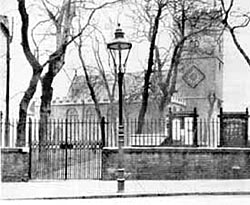< Previous | Contents | Next >
St. Nicholas Church
 |
THE times during which the present St. Nicholas Church was built were so very like our own that the site of the venerable, ugly, yet dignified building cannot do other than excite a sympathetic echo in our minds.
A church of St. Nicholas was erected on the site of the present building soon after the Conquest, and it seems to have been very like the St. Peter’s Church that we know. Whatever its appearance, it did its work usefully and quietly as a parish church until 1642. Then the times were out of joint.
King Charles and the Parliament were at each other’s throat, and the country rang with the battle cry of the Roundhead and Cavalier. Colonel Huchinson held Nottingham Castle for the Parliament, and was attacked by a body of Newarkers acting for the King. They were almost successful in their attempt but not quite.
However, they established themselves in the tower of the old St. Nicholas Church, and proceeded to bombard the garrison of the Castle with such effect that when they were finally dislodged, Colonel Hutchinson felt that he dare not expose his men to a repetition of the experience, and so caused the old church to be completely destroyed.
The homeless congregation were accommodated in a loft over St. Peter’s Chancel but they were once more rendered homeless by a fresh bombardment, for thirty-five years the site of St. Nicholas remained vacant, but at last in 1678 a fresh start was made and a new church was erected—the nucleus of the building we know. Men were war-weary and tired of being over-governed.
King Charles II. had been restored to the throne of his fathers a dozen years before, and all the golden promise of that anna mirabilis had faded into disappointment. The ancient nobility and gentry were impoverished by sequestration and taxation, and the new owners of wealth had not had time to realise their responsibilities.
All this and much more is reflected in the poorness of the architecture and the cheapness of the material of the portions of St. Nicholas Church which date from about the time of Titus Oates.
Nevertheless, there are few places in Nottingham where the quietness and dignity of the Eighteenth Century may be more readily recovered than within the walls of this ancient building.
